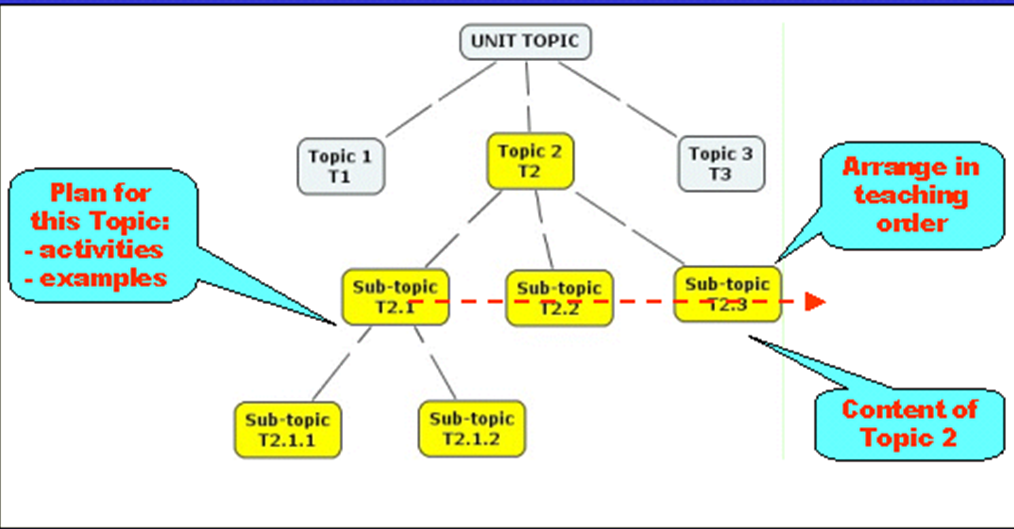Course Structure: Content and Resources
| Site: | Technology-Enabled Learning Lounge |
| Course: | Developing & Teaching Online Courses |
| Book: | Course Structure: Content and Resources |
| Printed by: | Guest user |
| Date: | Monday, 5 January 2026, 12:46 AM |
Description
As you 'chunk' and sequence the content for your course, you will explore how you can integrate Open Educational Resources (OER) into your content. Mimicking what is traditionally done without technology in teaching and learning is easy: you take your content and transpose it into an online format. The challenge is to think differently and use technology to transform the learning experience.
Structuring Content
Now that you have 'the big picture' for your course planned out, it is time to start sequencing the content, organising it into chunks that are manageable and help pace students through the course.
Sequencing
Once the learning objectives are well defined, you can start to think in terms of what topics you are going to cover to meet the objectives. As you think about the topics, you are going to start to see the sequence in which it makes sense to address them.... and... voila... this is you sequencing your content! Sequencing the content is not more than jotting down the topics to cover for each learning objective and in which order.
You can start the sequencing of your content with the help of a concept map that shows the relationships among concepts or by creating a hierarchy of topics if your content is fairly linear.


Reading Activity
COL's book "Creating Learning Materials for Open and Distance Learning" has a good section on methods for sequencing within a course.
Planning a logical sequence for the content topics provides learners with patterns that will foster the building of connections between the content topics and the practice activities. Learners will clearly see the purpose for their learning, which will result in a more meaningful learning experience.
Chunking
And since you already have jotted down the learning activities that will be required for each learning objective, you will be able to look at the sequence of topics to cover together with the necessary learning activities to see how they fit into larger, meaningful "chunks" of learning. Structuring content in small chunks helps learners solidify the relationships between concepts, especially if you use subtitles to provide an easy guide.
Pacing
As your content is in the proper sequence, in the right chunks, you can start to think about how to help learners pace themselves so that the learning experience does not get to be overwhelming. It is at this point that you start to think in terms of how much work students can realistically do in a week, for example. Then you are ready to start creating your course structure.

Reading Activity
COL's book "Creating Learning Materials for Open and Distance Learning" also has a good section on pacing the course.

Web Resources
Assignment
You can now start to work on creating a topic structure for your course content. Your course plan already has some columns filled in (learning objectives, activities and assessment). It is now time to update it by filling in the columns about the topics and the learning resources you will use. If it makes sense, you can indicate your structure with Modules and weeks in the appropriate columns as well. When you are finished, make sure your course plan is as complete as possible, keeping in mind the iterative nature of the planning process, and submit your work to the Create a Course Plan assignment box.
Online Course Look and Feel
After your course structure is created your online course starts to feel a bit more real. But what will the content pages look like? What resources will you use? Will you need images and videos to enhance your content? If so, do you have them prepared and ready to put in the content pages? Are you going to 're-invent the wheel' as you create content or are there Open Educational Resources (OER) that you can incorporate in your course?
Course Navigation
How students will navigate through the content you create is typically determined by the Learning Management System (LMS). Usually there isn't much flexibility in the interface: a table of contents with links to the pages you create and to course tools, such as gradebooks and profile settings. Some systems may allow a linear navigation (page turner style), as is the case in Moodle if you use the "book" block. Flexibility is inherently part of the course as you offer students choice:
- Allow students to choose what learning activities they want to engage in
- Allow students to choose how they explore the content you create.
Of course, adding multiple resources to your content pages also offers flexibility to your students in the way they go about their learning.
Content Pages
In most cases you won't control the look of the LMS environment, but you sure can control what you make available and the look of the content pages you create. Here are a few tips to create engaging content pages:
- Plan how much content to add to each page and keep it simple. Best practices speak to pages that do not require excessive vertical scrolling and that have a balance between "white" space and text to facilitate reading.
- Use titles and subtitles to organise and chunk your content: makes it easier for learners to find information an breaks long block of text, which are difficult to read online
- Use visual elements to present content. Use images, diagrams or flowcharts to present concepts visually or to illustrate actions or examples as much as possible. Sometimes a picture is worth a thousand words. Having said this, avoid using images for decoration purpose only. If there is no purpose for the image, don't crowd your page with it.
- The use of video is good to demonstrate processes, how to operate machinery, how to perform a task. There are many video resources available on YouTube, but you can also create your own videos easily, even with your phone camera. Caution about overusing video: it is not interactive and if too long, it will disengage learners. How many of you get distracted while watching a video? Especially if it is only a "talking head". I bet you start to look at your watch after a few minutes, or you start thinking about what you have to get from the grocery store on your way home!
- In an online environment, take advantage of available open educational resources (OER). You can link to existing resources and in some cases you can even embed them in your own page. More on OER next.
- Online learning environments offer many possibilities to engage learners. Make sure you incorporate a variety of learning activities that will engage learners at different levels.
When creating content and designing pages, take advantage of what online environments have to offer in terms of student engagement, collaboration and co-creation. It's not just about the "look", it is about creativity and thinking of different ways to engage learners with the content, stepping outside of the traditional role of the instructor / teacher.
Using OER
The following video shows the impact that Open Educational Resources (OER) can have in education. OER are free and adaptable resources that can be used for teaching and learning. These resources range from full courses, such as the MIT example, to small learning objects that can be incorporated into instructional content.
Now it is your turn to explore not only how OER can be integrated into your own course, but also how you can contribute to the collective of OER with your own creations!
Open Educational Resources (OER)
Wikipedia defines OER as:
This framework informs and guides the writing of learning objectives and learning assessment.

Webquest Activity
As part of this webquest activity you will be working in your assigned groups to:
- explain what are open educational resources within the context of a "culture of sharing"
- reflect on issues of quality surrounding the development and use of OER
- explain how OER can be integrated with your course content
To get started, distribute the links below across the members of each group.
Group 1, will do this webquest activity to create a comprehensive definition of OER, complete with examples and a brief analysis of how OER promote a "culture of sharing". The following weblinks will guide your quest:
- Wikipedia's OER definition
- Wikiversity on OER
- OER Commons
- UNESCO slides: Building a culture of sharing
- UNESCO - OER
- Bootstrapping a Culture of Sharing to Facilitate OER
Group 2, will examine issues of quality in the development and use of OER to make their own recommendations on criteria for a quality framework for assessing resources. The following weblinks will guide your quest:
- Achieve (rubrics for assessign OER)
- OER info kit
- Terry Anderson blog post on quality and usage of OER
- Wikieducator - Quality of OER
- Wikieducator - Evaluation of OER
- Educause - 7 things you should know about OER
- OTTER - University of Leicester
- Evaluating OER - Criteria from University of Maryland
- Wikieducator - OER Handbook (integrating OER in teaching and learning)
- OER info kit
- Integrating OER and Instructional design
- SCORE - Case studies
- HEA/JISC - OER integration case study
All groups will post the results of their quest to the OER discussion forum. Each group is allowed only one initial post and please indicate your group number in the subject line. The posts can be done in the form of text, video or sound files. Be as creative as you'd like, but make sure there's consensus within your group. Replies and comments to the initial posts are unlimited - please comment on the work of each group and ask questions.
Creative Commons
Traditionally, when anyone creates "anything", they automatically get an "all rights reserved" copyright to their creation. When the creation is something intangible (a creation of the mind) such as music for example, it is automatically protected by intellectual property law, in the same way that "all rights reserved" copyright protects other creations. Creative Commons (CC) is an alternative to this very restrictive copyright protection. CC makes it possible for creators to decide what they want to share (make available in the public domain) and the conditions under which shared creations are made available: as copyright owners, creators can decide what rights to keep and what rights to release so that others can reuse their creation. This Educause resource provides a brief overview of what creative commons is all about.

Activity
- This WikiEducator tutorial provides a good rationale for CC and Education and does a good job of introducing the various types of CC licenses.
- The P2PU site also includes a great section that discusses the use of CC licenses and provides an overview of the steps involved in choosing a license.
CC Licenses
Creative Commons licenses allow authors to determine how they want to share their creations. These licenses communicate which rights are reserved (if any) and which rights are waived for the benefit of other creators. Creative Commons licenses do not replace copyright, but are based upon it.
 Copyleft is a play on the word copyright. Notice how the symbol for copyleft is the reverse of the copyright symbol. As opposed to copyright, copyleft aims make a creation freely available to be modified (not necessarily free of charge) while requiring that resulting creations be free as well.
Copyleft is a play on the word copyright. Notice how the symbol for copyleft is the reverse of the copyright symbol. As opposed to copyright, copyleft aims make a creation freely available to be modified (not necessarily free of charge) while requiring that resulting creations be free as well.
Web Resources
Turning a Learning Resource into an OER
Using CC licensed materials or OER can save you precious time as you work on your course content and provides opportunities to enhance your content with different perspectives or even to build on your content by adding depth and breadth to a learning topic. So, perhaps giving back to the community and contributing your own resources may not be such a bad idea. We encourage you to be active collaborators and contribute to the world of CC. Here's how you can do it:
Repositories for OER
An easy way to search for OER is through the advanced search options in Google:
You can also use the advanced search option in Flickr when searching for CC images.
The following are reputable repositories that you can use to search for OER to integrate into your course content.

Web Resources
- Wikieducator - Collection of open e-learning content repositories
- Wikieducator - Catalogue of OER related sites
- OER Commons - Where it all started :-)
- OER Commons - Education
- OER Africa
- MIT Open Courseware
- Connexions
- OpenStax College - professional grade textbooks
- Free Learning - Aggregates resources
- SOL*R - shareable resources from BC Campus
- Merlot - learning objects repository
- Saylor
- Open Learn
- Curriki
- Utah State University
- TESSA
- OER tool kit
- Open Courseware Consortium
Free Images:
Free e-texts:
- Flat World Knowledge
- Bookboon
- Online collaborative tools
- College Open Textbooks
- Orange Grove Texts Plus - University of Florida
Integrating OER Into Your Course
The debate around quality has plagued OER from the very beginning. However, over the last decade there has been a tremendous amount of collaboration between individuals, as well as public and private educational institutions to establish quality criteria to guide the development of OER. This has resulted in several repositories that have been gaining notoriety as they host quality learning objects and resources, such as OER Commons, SOL*R, Merlot and OpenStax College among others.
As you search for OER to integrate into your course, it is recommended that you assess each resource you intend to use based on the context in which you need it as well as educational integrity. You may use your own criteria or a rubric such as the ones available at the Achieve site or the WikiEducator OER Handbook for Educators, which speaks to the various aspects to take into consideration when planning to integrate OER to enhance the curriculum. The following video guides you through the process of using the Achieve OER evaluation tool to assess OER objects:
Educators have come to recognise the potential of these repositories, as collaboration to re-use and remix objects continues to lead to increasingly equitable educational models.
Integrating OER into your courses has the potential to:
- allow for higher quality materials that include multiple perspectives on a topic. OER are often the result of international collaboration between diverse content creators around the world.
- engage learners in collaboration and sharing of knowledge
- prevent faculty from "re-inventing" the wheel... and therefore lower the costs of producing a course
- encourage faculty to share objects which will bring institutional recognition
How to Integrate OER?
Once you assess the OER you need and check for the licensing options, you need to decide whether you want to re-use, adapt and/or remix the object. Remember that an OER can be anything, from a single image to a complete course module. Depending on your needs and the resource you have identified, there are several ways you can integrate it into your own content:
- you can link to the resource
- you can embed the entire resource into your content page
- you can embed some elements of a specific OER in your content page (depending on the CC license under which the resource has been released)
- you can modify an existing OER (provided that the CC license allows for modifications) and embed the resulting work into your content page

Activity
- Search the OER Repositories and identify at least one OER that can be integrated into the course content you are developing.
- Assess the OER using a rubric - either from Achieve or your own.
- Check the CC licensing scheme for the OER.
- Decide which way is best to integrate the resource into your content.
- Integrate the specific OER in the content you are developing.
This brings you to the end of Module 4. Well done! Next you will be working on Module 5: The Development Stage, which includes three separate books that guide you through developing your course using Moodle. Don't forget to post any question you may have to the Course Q&A discussion.